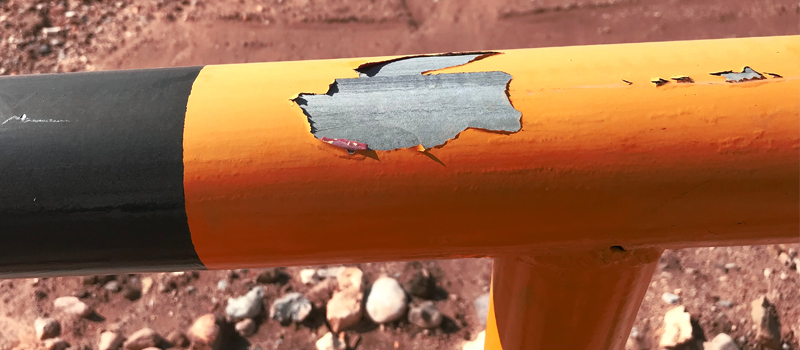Shop Talk: Coatings & Finishes
Friday, March 6, 2020

You can extend the life of your Onboard Systems equipment with proper touch-ups for coatings and finishes that are damaged during use in the field. As always, your best source of information for ongoing care and maintenance of your Onboard Systems equipment can be found in the CMM Manual (122-XXX-XX format) for your cargo hook. You can download copies of all user manuals at our website.
In general, your Onboard equipment has stainless steel, anodized, painted, or powder coated surfaces that need regular inspection and maintenance. Here are some general maintenance tips for each of these surface types.
Stainless Steel Surfaces
For corrosion on the load beam assembly, manual release lever, solenoid cam, or armor plate cargo hook components, our CMMs recommend a glass bead blast at less than 30 PSI (2.11 KGF/CM2), followed by a passivation treatment per AMS-QQ-P-35 or ASTM A967.
Blend any gouges or nicks on the load beam, keeper, or keeper assembly as required to provide smooth transitions and ensure that load rings will not hang up during release, then passivate per AMS-QQ-P-35 or ASTM A967.
Anodized Surfaces
For chips or scratches to the anodized finish on the manual release lever cover, solenoid cover, or side plate components, our CMMs recommend blending the edges of the finish around the bare metal at a 10:1 ratio as required to provide smooth transitions. Then apply alodine (MIL-DTL-5541) and zinc chromate primer (MIL-PRF-23377 or similar) to affected surfaces. You can also black anodize per MIL-A-8625 Type II, Class 2 after non-destructive inspection.
Painted Surfaces
Onboard paints many of our suspension system components to protect the metal from rust and corrosion due to moisture, rain, and sunlight exposure during use. Scratches or areas with peeling paint can usually be touched-up to protect the bare metal by blending as required to provide smooth transitions between the paint edges and the bare metal. Apply one coat of BMS 10-11 Type 1 primer or optionally MIL-PRF-23377 Type 1 Epoxy, followed by one coat of BMS 10-11 Type 2, Class B, 702 white gloss top coat or optionally MIL- PRF-85285 Type 1 high solid polyurethane white coating.
Powder Coated Surfaces
Onboard uses powder coating on all of our remote equipment protective cages due to its durability, excellent resistance to the effects of weather, chemicals, and other contaminants, and superior color retention properties. However, even high quality coatings can sustain damage over time, resulting in the need for effective powder coating repairs. Small chips in powder coated surfaces can usually be touched-up to protect the bare metal; however, if there are large areas of exposed metal, it is best to send the cage or swing out to a local powder coating shop to have the original powder coating removed and completely replaced, as we do whenever you send in your equipment for factory overhaul.
There are many good sources of information and video tutorials available online about repairing small areas of chipped powder coating, but in general, the recommended procedure typically involves these steps:
- Wash the area with a detergent cleaner to remove water based contaminants, followed by a wax and grease remover. Then wipe the surface down with isopropyl alcohol (IPA).
- Remove all loose and flaking coatings from the damaged area with a wire brush or putty knife, then blend as required to provide smooth transitions between the coating edges and the bare metal.
- For better touch-up adhesion, lightly sand the area with 180 grit sandpaper or a red Scotchbrite pad. Remove any dust by wiping the surface down with IPA.
- Apply zinc chromate primer (MIL-PRF-23377 or similar).
- Apply color match spray or liquid touch up using an aerospace grade coating.
If you have any questions about caring for your Onboard Systems equipment, feel free to reach out to one of our technical support representatives by phone or email, or through our online support form.
Tags
vol17-iss1touch-upscoatingsfinishesshop talkMore Articles
Load Cell Nut Adjustments
Don't torque that nut! Here's why you should never adjust the nuts on your load cells.
Troubleshooting Onboard Weighing Systems
Download our Electronic Load Weigh System Troubleshooting Guide for recommended troubleshooting procedures that can be implemented in the field to diagnose and resolve problems.
Inspection Requirements for Other Equipment
Learn about inspection requirements for suspension systems, hydraulic release handles, and electric swivels.
Change in Hydraulic Fluid
Onboard has switched to MIL-PRF-87257 hydraulic fluid.
Mechanical Release Cables
Get the 411 on mechanical release cable maintenance.
Lubricants
How to apply the right lubricants, to key locations, at appropriate intervals.
Inspection Schedules
Get the 411 on required inspections and maintenance intervals for your cargo hook.


